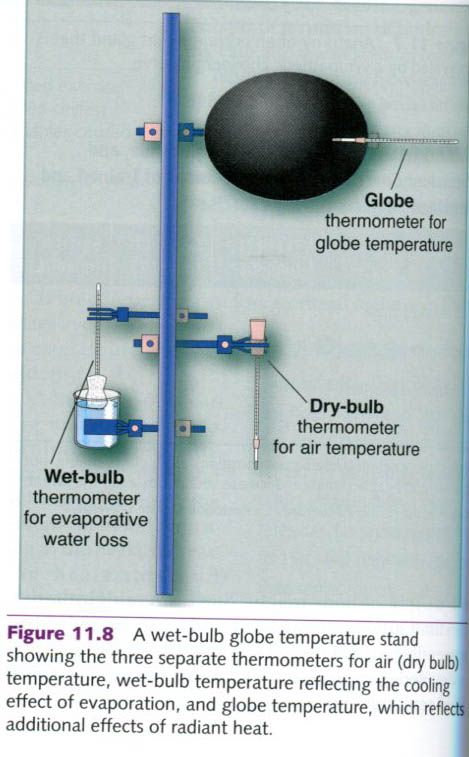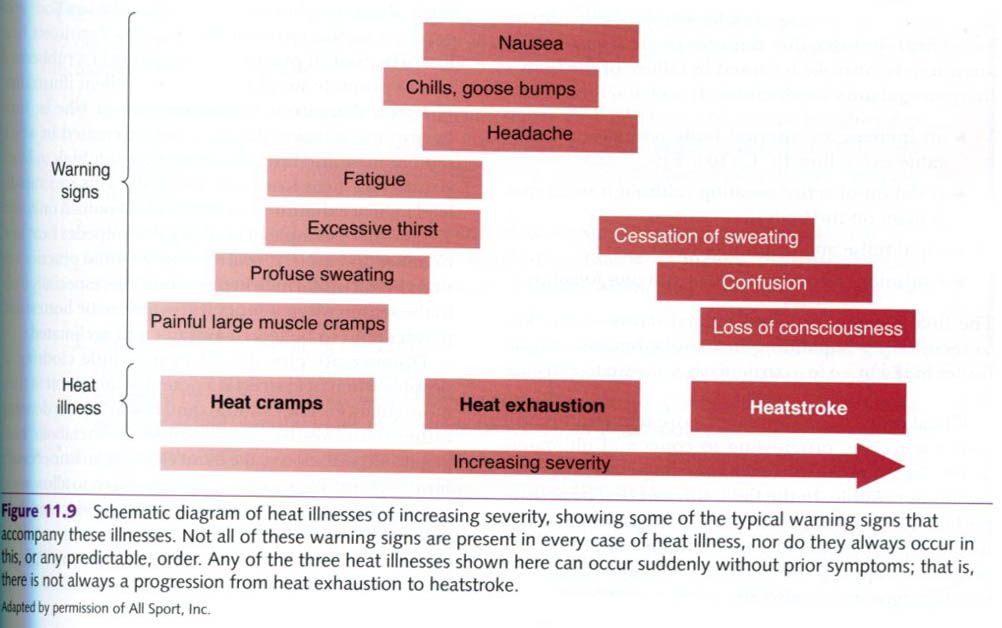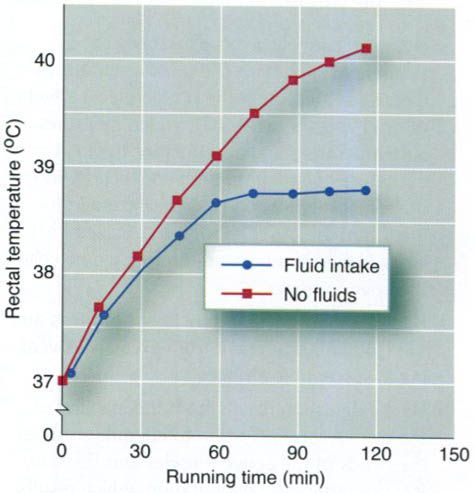- Air temperature
- Humidity
- Air velocity
- Amount of thermal radiation.
All these factors influence the degree of heat
stress that a person experiences. The contribution of each factor to the total
heat stress under various environmental conditions can actually be predicted
mathematically using advanced heat balance equations.
An individual exercising on a bright, sunny day
with an air temperature of 23°C(73.4°F) and no measurable wind experiences considerably
more heat stress than someone exercising in the same air temperature but under
cloud cover and with a slight breeze. At temperatures above skin temperature,
which is normally 32 to 33°C(90-92°F), radiation, conduction, and convection substantially add to the body’s heat load rather
than acting as avenues for heat loss. How, then, we can judge the amount of
heat stress to which an individual may be exposed?
Measuring heat stress
It has become common to hear about the “heat
index” on local weather channels. The heat index, a complex equation involving
air temperature and relative humidity, is a measure of how hot it feels, that
is, how we perceive the heat. However, it does not do a good job of reflecting
the physiological stress on humans, so its use is limited in exercise
physiology. Through the years, efforts have been made to quantify atmospheric
variables into a single index that would reflect the physiological stress on an
individual. In the 1970s, wet-bulb globe
temperature(WGBT) was devised to simultaneously account for conduction, convection, evaporation, and radiation. It is based on three different thermometer readings and provides
a single temperature to estimate the cooling capacity of the surrounding
environment.
The dry-bulb temperature(Tdb) is the
actual air temperature one would measure with a typical thermometer. A second
thermometer has a wet bulb that is kept moist. As water evaporates from this
bulb, its temperature(Twb) will be lower than the dry bulb’s,
reflecting the effect of sweat evaporating from the skin. The difference between the wet- and dry-bulb
temperatures indicates the environment’s capacity for cooling by evaporation. In still air with 100%
relative humidity, these two bulb temperatures are the same because evaporation is impossible. Lower
humidity and moving air promote evaporation, increasing the difference between
these two bulb temperatures. The third thermometer, placed inside a black
globe, typically shows a temperature higher than Tdb as the globe
absorbs radiant heat. Thus, its temperature(Tg) is a good
indicator of the environment’s radiant heat load.
The temperatures from these three thermometers
can be combined into the following equation to estimate the overall atmospheric
challenge to body temperature in outdoor environments:
WGBT
= 0.1 Tdb + 0.7 Twb + 0.2 Tg.
The fact that the coefficient for Twb is the largest reflects the importance of
sweat evaporation in the physiology of heat exchange. Also note that WGBT
reflects only the environment’s impact on heat stress and is most effectively
used along with a measure or estimate of metabolic heat production.
This measurement of thermal stress is now
routinely used by coaches, medical directors of distance races and triathlons,
and athletic trainers to anticipate the health risks associated with athletic
competitions in thermally stressful environment.
Heat-related disorders
Exposure to the combination of external heat
stress and metabolically generated heat can lead to three heat-related
disorders: heat cramps, heat exhaustion,
and heatstroke.
Heat cramps
Heat
cramps, the least serious of the three heat disorders, are characterized by
severe and painful cramping or large skeletal muscles. They involve primarily
the muscles that are most heavily used during exercise, and such instances of
athletes “locking up” are different from cramps everyone has experienced in
small muscles. Heat cramps
are brought on by sodium losses and dehydration that accompany high rates of
sweating, and thus are most common in heavy sweaters who lose a lot of sodium
in their sweat. (A common misconception is that potassium-rich foods like bananas will prevent heat cramps.) Heat
cramps can be prevented or minimized in susceptible athletes by proper
hydration practices involving liberal salt intake with foods and in beverages
consumed during exercise. Treatment for these cramps involves moving the
stricken individual to a cooler location and administering a saline solution,
either orally or intravenously if necessary.
Heat exhaustion
Heat
exhaustion typically is accompanied by such symptoms as extreme fatique,
dizziness, nausea, vomiting, fainting, and a weak, rapid pulse. It is caused by the cardiovascular system’s
inability to adequately meet the body’s needs as it becomes severely
dehydrated. During exercise in heat, active muscles and skin compete for a
share of a limited, and decreasing, blood
volume. Heat exhaustion may result when these simultaneous demands cannot
be met, and it typically occurs when blood
volume decreases as a result of excessive fluid loss from profuse sweating.
A second form of heat exhaustion, from sodium depletion, is rare in athletes.
Therefore, heat exhaustion can be thought of as a syndrome of dehydration and
should be treated as such.
With heat exhaustion, the thermoregulatory
mechanisms are functioning but cannot dissipate heat quickly enough because
insufficient blood volume is
available to allow adequate blood flow
to the skin. Although the condition often occurs during mild to moderate exercise
in the heat, it is not necessarily accompanied by extremely high core
temperatures. Some people who collapse from heat exhaustion have core
temperatures well below 39°C(102.2°F). People who are unfit or not acclimated
to the heat are more susceptible than others to heat exhaustion.
Treatment for victims of heat exhaustion
involves rest in a cooler environment with their feet elevated to facilitate
return of blood to the heart. If the person is conscious,
administration of salt water is usually recommended. If the person is
unconscious, medically supervised intravenous administration of saline solution
is recommended.
Heatstroke
Heatstroke
is a life-threatening
heat disorder that requires immediate medical attention. Heatstroke is caused
by failure of the body’s thermoregulatory mechanisms. It is characterized by:
- An increase in internal body
temperature to a value exceeding 40°C(104°F);
- Cessation of active
sweating(although sweat may remain on the body);
- Rapid pulse and respiration;
- Confusion, disorientation,
or unconsciousness.
The final element – altered mental status – is
the key to recognizing impending heatstroke because neural tissues in the brain
are particularly sensitive to extreme heat.
If heatstroke is left untreated, core
temperature will continue to rise, progressing to coma and ultimately death.
Treatment involves cooling the person’s body as rapidly as possible. In the
field, this can best be accomplished by immersing the victim in a bath of ice
water. In cases where immersing the victim is not possible or prudent, wrapping
the body in cold, wet sheets and fanning vigorously is also an option.
For the athlete, heatstroke is not just a
problem associated with extreme conditions. Studies have reported rectal
temperatures above 40.5°C(104.9°F) in marathon runners who successfully
completed races conducted under relatively moderate thermal conditions.
Preventing hyperthermia
We can do little about environmental
conditions. Thus, in threatening conditions, athletes must decrease their
effort(and thus their metabolic heat production) in order to reduce their risk
of overheating. Athletes, coaches, and sport organizers should be able to
recognize the symptoms of heat illness.
To prevent heat disorders, several simple
precautions should be taken. Competition and practice should not be held
outdoors when the WGBT is more than 28°C(82.4°F) unless special precautions are
taken. Scheduling practices and events either in the early morning or in the
late evening avoids the severe heat stress of midday. Fluids should be readily
available, and drink breaks should be scheduled every 15 to 30min, with a goal
of matching fluid intake to sweat loss. This is best accomplished by having
athletes weigh themselves before and after exercise sessions and learn to estimate
their fluid needs.
Clothing is another important consideration.
Obviously, the more clothing that is worn, the less body area exposed to the
environment to allow for direct heat loss. The foolish practice of exercising
in a rubberized suit to promote weight loss from the body. This can rapidly
lead to heat exhaustion or heatstroke. Football uniforms are another example of
clothing that impedes heat loss. Coaches and athletic trainers should avoid
practice sessions in full uniforms whenever possible, especially early in the
season when temperatures tend to be hottest and players tend to be less fit and
not well acclimated.
Distance athletes should wear as little
clothing as possible when heat stress is a potential limitation to thermoregulation. They should tend
toward underdressing rather than overdressing, because the metabolic heat
generated will soon make extra clothing an unnecessary burden. Clothing should
be loosely woven to allow sweat to be absorbed and wicked away from the skin
and light colored to reflect heat back to the environment. Hats should be worn
during exercise in bright sunlight or when cloud cover is limited.
It is also important to maintain hydration of
the body, since the body loses considerable water through sweating. Briefly,
drinking fluid both before and during exercise can greatly reduce the negative
effects of exercising in the heat. Adequate fluid intake will attenuate the
increase in core body temperature and heart rate normally seen when a person exercises in the heat and will allow
exercise to be continued longer.












0 коментара:
Постави коментар